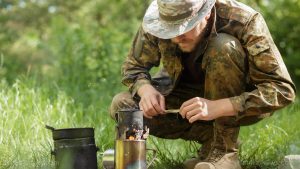If you’re a homesteader, one of your top priorities is keeping your chickens healthy.
Chickens provide eggs and meat for your family, so it’s important to keep them in good condition. One way to do that is by giving them herbs packed with nutrients and vitamins to eat and not have to resort to using expensive antibiotics or chemical-based products.
Each of these has a variety of micro and macronutrients, and in addition to using them internally, you can also use them topically to help treat any chicken illnesses or injuries.
1. Mint is one of the best herbs you can grow for your chickens. Not only does it lower body temperature, helping to keep your chickens cool and calm on a hot summer’s day, but it can also be used to destress and for its calming effects. This makes it a wonderful addition to a nesting box, where it’s more important than ever that your chickens remain relaxed. You can even put mint in your chickens’ water supply for a cool and refreshing drink. Another option is to hang bundles of mint around the coop. It is a natural rodent and insect deterrent, helping to discourage flies and other pests. You can provide harvested mint directly to your chickens or you can grow some in your garden for a fun, chicken friendly pecking garden. Just be warned wherever you grow mint, it will multiply rapidly. Where you once had one plant you will soon have dozens of others! However you choose to give mint to your flock, know that there are countless varieties to choose from including chocolate mint, lemon balm, catmint, peppermint, spearmint.
2. Lavender – is an herb that both you and your chickens are sure to love having around! It has a lovely smell, and can help your chickens by repelling pests in the coop as pests hate it! To use it, hang bundles in the coop or put it in a nesting box. It will help them calm down and has a relaxing effect. Lavender even has benefits for the circulatory system. Put some in the dust bath, and your chickens will enjoy visiting it each time.
3. Oregano – is another one of the best herbs to give your chickens. This one has strong antiparasitic and antibacterial properties. It’s also loaded with calcium, vitamins, and antioxidants, helping to support healthy immune and respiratory functioning. To use it, just chop fresh oregano leaves and mix it into the feed. As a perennial, oregano spreads easily, but not as bad as mint does.
4. Comfrey – is considered a weed by some, but if you have chickens, this is an herb you should definitely consider growing for your birds. It has long standing medicinal properties and there are many ways you can use it for chickens. Feed it to them fresh – it helps with digestion. You can also grow it as a perennial and allow your chickens to free range among the leaves. Some homesteaders even choose to make a salve out of comfrey leaves. It can be used on sore muscles, scrapes, scratches, bites, and more, helping to heal wounds of all kinds.
5. Calendula – Also known as the pot marigold, calendula is another healing herb to consider growing for your chickens. It is a herbaceous plant that is closely related to the daisy. You can tuck it between your vegetable plants to repel pests, and to give your chickens something to snack on. Also known to repel insects, making it a valuable choice for the infestation-prone chicken coop and nesting boxes. Flowers are edible – if your chickens choose to munch on calendula, you may find that the egg yolks have a vibrant orange color. High in oleanolic acid, which is an anti-inflammatory agent that has powerful antioxidant and antibacterial properties. Use it on scrapes or cuts, or even as a salve to treat prolapsed vents.
6. Thyme – Perhaps one of the best culinary herbs, thyme is also a great option for chickens. Bugs aren’t fond of the smell – all you have to do is hang a few bundles around the run or sprinkle a bit in the nest boxes. Pests are gone!
There are many types of thyme you can grow and give to your chickens. Of them, lemon thyme has a wonderful citrusy smell that insects particularly hate. Most varieties of thyme have antibacterial properties, too, along with antibiotic benefits. Like mint, thyme also has a tendency to spread (though perhaps not quite as bad). It is a great groundcover, if you have the space – even the most aggressive chickens will have a hard time destroying it.
7. Stinging Nettles – considered weeds by many. and if you find yourself wrapped up in a patch of them, you’ll likely not want to view them as anything but a weed! Have some patience, though – and consider relocating the stinging nettles to the chicken coop. Here, they have lots of benefits for your chickens. They can help with both blood and nerve health, and are rich in crucial vitamins and minerals that your chickens need to stay healthy.
8. Garlic – is also rich in nutrients for your chickens – it has antiparasitic properties. Just add a dash to your chickens’ feed and you’ll be amazed at the results. It also has antimicrobial and antibiotic properties.
9. Nasturtium – are an easy to grow, flowering plant often used in gardens, require little maintenance. In addition, nasturtiums are known for their ability to repel pests, making them a valuable asset in any garden. Nasturtiums can also be used to benefit chickens. When chickens eat nasturtiums, they ingest compounds that help to prevent illnesses such as coccidiosis. In addition, the high levels of Vitamin C in nasturtiums can help to boost the immune system and repel parasites.
10. Yarrow – is a versatile herb, often found growing in the wild, that can be used for a variety of purposes, including as a natural remedy for chickens. This herb has antibacterial, anti-inflammatory, and astringent properties, making it effective in treating a range of chicken ailments, from colds and respiratory problems to digestive issues. Yarrow can be administered orally or topically, and is safe for regular use. When used as a preventative measure, yarrow can help to keep chickens healthy and free from disease. This makes it an ideal addition to any chicken coop.
11. Basil – is an aromatic herb that is commonly used in Mediterranean cuisine. Basil contains a variety of vitamins and minerals essential for chicken health, including vitamin A, vitamin C, iron, and calcium and basil can help to boost the immune system, making chickens less susceptible to disease. Fresh basil is best, but dried basil can also be used.
Simply sprinkle a few tablespoons of basil onto your chickens’ food, or add it to their water dish. Your chickens will love the taste of this flavorful herb.
12. Parsley – This leafy green vegetable is packed with nutrients, including vitamin A, vitamin K, iron, and calcium.
Chickens love to eat parsley, and it can help to boost their immune system and keep them healthy and can help keep chickens’ coops clean by absorbing odors. As a result, parsley is an excellent way to keep your chickens happy and healthy.
13. Dill – You can add this versatile herb to their diet in a variety of ways. Fresh dill can be scattered in the coop or added to chicken feed. You can also dry dill and use it to make homemade chicken treats. It is also rich in vitamins and minerals. The herb contains vitamin A, which is essential for good vision, and calcium, which helps to strengthen bones.
14. Sage – is an herb that has a long history of use in cooking. It is also known for its medicinal properties, and it has been used to treat a variety of ailments. Recently, sage has also been gaining popularity as a natural way to control parasites in chickens. Chickens are susceptible to a number of parasites, including mites and ticks. These parasites can cause skin irritation, feather loss, and anemia. Sage oil contains compounds that have been shown to be effective against most common types of parasites. When added to the chicken coop, sage oil can help to keep chickens healthy and free of pests.
15. Echinacea – also known as coneflower, is a pretty addition to any flower garden. But this plant is not just a pretty face – it also has many benefits for chickens. Chickens are susceptible to a variety of illnesses, and echinacea can help to boost their immune systems and fight off disease. This herb is also effective in treating respiratory infections, and can be added to chicken feed or given as a treat. In addition, echinacea is rich in vitamins and minerals that are essential for chicken health.
A Few More Healthy Herbs for Chickens
Whether you’re interested in growing perennial herbs (those that come back each year) or annual ones (herbs you will need to replant) for your chickens, it’s easy to see that there are plenty of options to choose from.
Here are 20 more for you to choose from: Lemon balm, Rosemary, Plantain, Bee balm (also known as monarda), Chamomile, Fennel, Bay leaves, Borage, Catnip, Cayenne, Chervil, Chives, Cilantro, Dandelion, Goldenseal, Hyssop, Chickweed, Lovage, Pineapple sage, Tarragon.
How to Use Herbs for Your Chickens
The easiest way is to just give them to your chickens to eat fresh. You can also hang a few in the coop to let them pick at them, or mix them into the feed. You can even use herbs as a form of chicken aromatherapy – simply hang herbs in the chicken coop and let them work their magic!
Just make sure you remove any leftover herbs (regardless of which method you try) within a few days of feeding them out.
That way, they don’t start to mold and decompose in your coop.
Another option is to grow these medicinal herbs around the coop and run area – just be warned, your chickens might destroy them!
You can process your favorite herbs into healing salves or essential oils.
Choose to make an essential oil spray, and you can use this spray directly on your chickens or to clean particularly grimy areas of the coop, like the nesting boxes.
A final method of giving herbs to your chickens is to put them in the nesting boxes. This doesn’t mean you can get away with not cleaning the nesting boxes, but it does provide a nice way to keep the nesting boxes smelling great and your chickens happy and healthy.
Herbs are a great way to keep your chickens healthy and can be used as both preventative and treatment measures.





